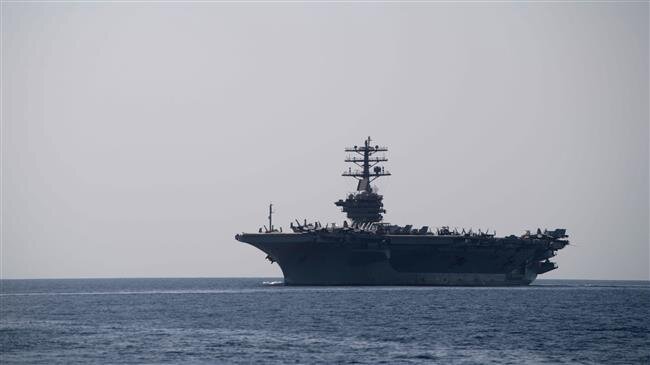U.S. aircraft carrier enters Persian Gulf amid heightened tensions

TEHRAN — A U.S. aircraft carrier has entered the Persian Gulf for the first time in ten months, as tensions soar between Tehran and Washington over a number of issues.
USS Nimitz passed through the Strait of Hormuz with the guided-missile cruisers USS Princeton and USS Philippine Sea and guided-missile destroyer USS Sterett, U.S. 5th Fleet announced on Friday.
“The [Carrier Strike Group] will operate and train alongside regional and coalition partners, and provide naval aviation support to Operation Inherent Resolve,” the statement read.
Nimitz is the first carrier to operate in the Persian Gulf since USS Abraham Lincoln made the Strait of Hormuz transit last November. The last capital ship to sail in the Persian Gulf was USS Bataan in April.
“The Nimitz Strike Group has been operating in the 5th Fleet area of operations since July, and is at the peak of readiness,” strike group commander Rear Admiral Jim Kirk said.
“We will continue our support to the joint force while we operate from the (Persian) Gulf alongside our regional and coalition partners,” he added.
Tehran and Washington have been at loggerheads since Donald Trump became president.
The Trump administration is set to reimpose UN sanctions against Iran under the Iran nuclear deal, despite the fact that other parties to the deal have resoundingly rejected the U.S. measure as illegal.
It is the latest move in the “maximum pressure” campaign against Tehran, which the U.S. pursued after it withdrew from the nuclear deal, officially called the Joint Comprehensive Plan of Action (JCPOA), in May 2018.
It comes after Washington failed to extend the conventional weapons embargo set to expire next month under the JCPOA.
“We expect every nation to comply with UN Security Council resolutions -- period, full stop,” U.S. Secretary of State Mike Pompeo said Thursday.
“And the United States is intent on enforcing all the UN Security Council resolutions. And come Monday, there will be a new series of UN Security Council resolutions that we enforce, and we intend to ask every country to stand behind them,” he added.
Meanwhile, Britain, France and Germany told the UN Security Council on Friday that UN sanctions relief for Iran would continue beyond September 20, when the U.S. asserts that the sanctions should be reimposed.
In a letter to the 15-member body, seen by Reuters, the three European parties to the JCPOA said any decision or action taken to reimpose UN sanctions “would be incapable of legal effect.”
Iran has also dismissed the U.S. bid, with President Hassan Rouhani congratulating the Iranian people on the imminent defeat of the U.S. to trigger the so-called snapback sanctions against Tehran.
“In advance, I congratulate the Iranian nation on the upcoming Saturday and Sunday victory [of Iran] and the U.S. humiliating defeat,” Rouhani said during a cabinet session on Wednesday morning.
Foreign Minister Mohammad Javad Zarif said Pompeo was wrong to think that the UN sanctions on Iran would be reimposed on September 20.
“Wrong again, Pompeo. Nothing new happens on 9/20. Just read Resolution 2231. Bolton—who convinced the boss to order you to ‘CEASE U.S. participation’—did. In his words: Process is not ‘simple’, automatic or snappy. But intentionally ‘complex & lengthy’. U.S. is NOT a participant,” Zarif tweeted on Thursday.
On Tuesday, Zarif wrote in a tweet that Trump is being pushed toward a war with Iran by “the habitual liar”, referring to Pompeo.
“The habitual liar bamboozled @realdonaldtrump into assassinating ISIS' enemy #1 by raising a false alarm,” Zarif said, adding, “Now he's trying to sucker him into mother of all quagmires by leaking a new false alarm. Time to wake up.”
It came hours after Trump threatened Iran with a “1,000 times greater” attack in response to a fake story run by Politico, which claimed Iran is planning to assassinate the U.S. ambassador to South Africa.
MH/PA
